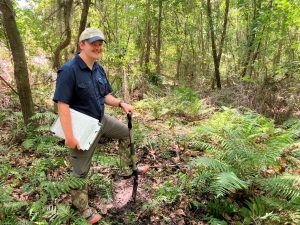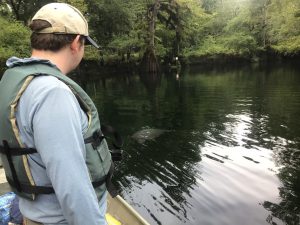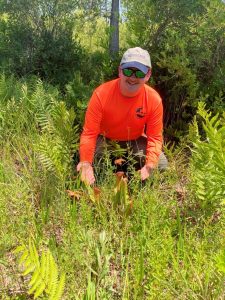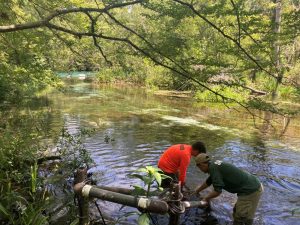Written by Trey Holland, 2024 undergraduate summer intern hosted by the Suwannee River Water Management District

Overview
This summer, I had the pleasure of interning at the Suwannee River Water Management District (SRWMD) through the Nature Coast Biological Station (NCBS) under the guidance of Stephanie Armstrong, Katie McBride, and Susie Hetrick. Initially, I had little knowledge of water quality and its measurement, but through their mentorship, I quickly became involved in continuous monitoring, my own Turbidity project, and various district initiatives. This experience not only expanded my technical skills but also deepened my understanding of Florida Springs and North Florida in general.

The District
The Suwannee River Water Management District (SRWMD), proudly referred to as Florida’s “5th largest district,” is one of Florida’s five key water management districts. It plays a crucial role in protecting and preserving North Florida’s water resources for future generations. Throughout my internship, I had the unique opportunity to see this mission in action, not just in the Water Resources office but also in Land Management, Outreach, Hydrological Data Services, Minimum Flows and Levels, and Environmental Resource Permitting offices. By engaging with these diverse teams, I gained a comprehensive understanding of the district’s ecosystem, seeing firsthand how each division contributes to sustainable water management and the district’s goals. This experience provided me with a broader perspective and a deeper appreciation for the district’s comprehensive approach to environmental stewardship.

Fieldwork
During this internship, I had numerous opportunities to venture into the field and experience firsthand the diverse landscapes that the Suwannee River Water Management District (SRWMD) protects and manages. I had the privilege of assisting Stephanie Armstrong and Katie McBride with the district’s continuous monitoring (CM) program at three of North Florida’s stunning springs—Gilchrist Blue, Peacock, and Ichetucknee. Although some days the springs were browned out, these experiences allowed me to gain a deeper understanding of essential water quality parameters, such as turbidity and pH, while also providing hands-on experience with field equipment like YSI water quality sondes. Beyond CM work, I was also fortunate to participate in a Rare Species Survey in Mallory Swamp, take flow measurements, engage in a wetland assessment, visit forestry sites, and assist in measuring groundwater well levels. Each of these activities broadened my understanding of the district’s comprehensive approach to managing and preserving Florida’s natural resources.

Turbidity Project
Between fieldwork and shadowing various offices, I embarked on a project to explore the correlation between high visitor attendance and increased turbidity levels in three beautiful North Florida Springs: Gilchrist Blue, Peacock, and Ichetucknee. Utilizing the district’s in-house software and obtaining visitation data from the state, I employed R to analyze data and create plots that illustrated the relationship between turbidity and attendance. This project was invaluable, teaching me that real-world data is often neither clean nor straightforward to work with. I encountered several challenges along the way, requiring me to try different approaches to draw accurate conclusions. This experience highlighted the complexities of working with dynamic, natural environments, where data collection is inherently more challenging than in a controlled lab setting. It also reinforced the importance of adaptability and problem-solving in environmental science, skills that will be crucial in my future career.
Final Words
I just want to say thank you to everyone at the district especially Stephanie Armstrong, Katie McBride, and Susie Hetrick for making my summer very special and fun. You all made me feel so welcome. Thank you all for mentoring me and teaching me so much! I will greatly miss Susie’s Banana Bread! Thank you also to UF/IFAS and the Nature Coast Biological Station for giving me this opportunity.
Learn more about SRWMD here.
| Follow the link to learn more about the UF/IFAS NCBS Undergraduate Summer Internship program. Read more intern blogs here. |
Featured image credit: UF/IFAS Photo by Tyler Jones
 1
1
